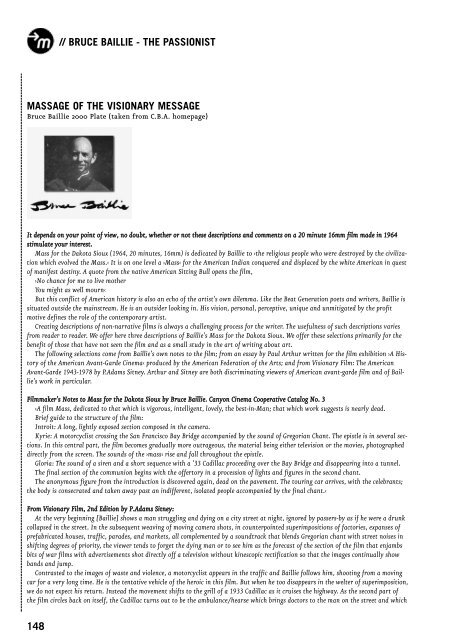You also want an ePaper? Increase the reach of your titles
YUMPU automatically turns print PDFs into web optimized ePapers that Google loves.
BRUCE BAILLIE - THE PASSIONIST<br />
MASSAGE OF THE VISIONARY MESSAGE<br />
Bruce Baillie 2000 Plate (taken from C.B.A. homepage)<br />
It depends on your point of view, no doubt, whether or not these descriptions and comments on a 20 minute 16mm film made in 1964<br />
stimulate your interest.<br />
Mass for the Dakota Sioux (1964, 20 minutes, 16mm) is dedicated by Baillie to ›the religious people who were destroyed by the civilization<br />
which evolved the Mass.‹ It is on one level a ›Mass‹ for the American Indian conquered and displaced by the white American in quest<br />
of manifest destiny. A quote from the native American Sitting Bull opens the film,<br />
›No chance for me to live mother<br />
You might as well mourn‹<br />
But this conflict of American history is also an echo of the artist's own dilemma. Like the Beat Generation poets and writers, Baillie is<br />
situated outside the mainstream. He is an outsider looking in. His vision, personal, perceptive, unique and unmitigated by the profit<br />
motive defines the role of the contemporary artist.<br />
Creating descriptions of non-narrative films is always a challenging process for the writer. The usefulness of such descriptions varies<br />
from reader to reader. We offer here three descriptions of Baillie's Mass for the Dakota Sioux. We offer these selections primarily for the<br />
benefit of those that have not seen the film and as a small study in the art of writing about art.<br />
The following selections come from Baillie's own notes to the film; from an essay by Paul Arthur written for the film exhibition ›A History<br />
of the American Avant-Garde Cinema‹ produced by the American Federation of the Arts; and from Visionary Film: The American<br />
Avant-Garde 1943-1978 by P.Adams Sitney. Arthur and Sitney are both discriminating viewers of American avant-garde film and of Baillie's<br />
work in particular.<br />
Filmmaker's Notes to Mass for the Dakota Sioux by Bruce Baillie. Canyon Cinema Cooperative Catalog No. 3<br />
›A film Mass, dedicated to that which is vigorous, intelligent, lovely, the best-in-Man; that which work suggests is nearly dead.<br />
Brief guide to the structure of the film:<br />
Introit: A long, lightly exposed section composed in the camera.<br />
Kyrie: A motorcyclist crossing the San Francisco Bay Bridge accompanied by the sound of Gregorian Chant. The epistle is in several sections.<br />
In this central part, the film becomes gradually more outrageous, the material being either television or the movies, photographed<br />
directly from the screen. The sounds of the ›mass‹ rise and fall throughout the epistle.<br />
Gloria: The sound of a siren and a short sequence with a '33 Cadillac proceeding over the Bay Bridge and disappearing into a tunnel.<br />
The final section of the communion begins with the offertory in a procession of lights and figures in the second chant.<br />
The anonymous figure from the introduction is discovered again, dead on the pavement. The touring car arrives, with the celebrants;<br />
the body is consecrated and taken away past an indifferent, isolated people accompanied by the final chant.‹<br />
From Visionary Film, 2nd Edition by P.Adams Sitney:<br />
At the very beginning [Baillie] shows a man struggling and dying on a city street at night, ignored by passers-by as if he were a drunk<br />
collapsed in the street. In the subsequent weaving of moving camera shots, in counterpointed superimpositions of factories, expanses of<br />
prefabricated houses, traffic, parades, and markets, all complemented by a soundtrack that blends Gregorian chant with street noises in<br />
shifting degrees of priority, the viewer tends to forget the dying man or to see him as the forecast of the section of the film that enjambs<br />
bits of war films with advertisements shot directly off a television without kinescopic rectification so that the images continually show<br />
bands and jump.<br />
Contrasted to the images of waste and violence, a motorcyclist appears in the traffic and Baillie follows him, shooting from a moving<br />
car for a very long time. He is the tentative vehicle of the heroic in this film. But when he too disappears in the welter of superimposition,<br />
we do not expect his return. Instead the movement shifts to the grill of a 1933 Cadillac as it cruises the highway. As the second part of<br />
the film circles back on itself, the Cadillac turns out to be the ambulance/hearse which brings doctors to the man on the street and which<br />
148












